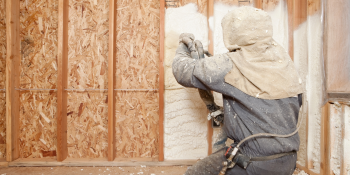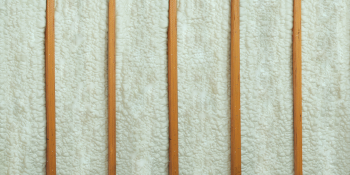Q&A Forums
Can I implement this wall/ceiling system? Post New Topic | Post Reply
| Author | Comments |
|---|---|
|
drew renshaw
Posted: Aug 25, 2010 08:48 AM
|
Can I implement this wall/ceiling system?
I am a home builder in Memphis, TN; Mixed/humid. I am looking to pull ahead of the pack with regards to house performance. I am able to get very good pricing on 2 inch thick Polyiso boards and would like to design a system for my climate using them and spray foam. Due to cost concerns I cannot afford to spray more than a half to one inch flash coat. My thoughts on an affordable insulation system are these:Walls - 2x4 walls with required half inch waferboard sheathing on entire structure, covered by my 2 inch polyiso, inside a flashcoat of spray and batt R-11 to save money. Ceilings - 2x8 joists with 2 inch polyiso attached to ceiling and covered by sheetrock, then blow cellulose on top for whatever depth r value I desire. Would this work, perform well, and not have any moisture problems? Should I consider flashcoating the ceiling after I install the polyiso boards on the ceiling and then blowing or would that be too tight? Should I be worried about sandwiching the waferboard with 2 types of foam insulation? |
|
mason
Posted: Aug 25, 2010 11:18 AM
|
I can see some challenges with your prospective design. 2 inches of polysio board on the outside of your sheathing will provide good insulation and stop thermal bridging, but it may be difficult to cut in around your doors and windows with that much insulation on the outside. You would not want to use a foil backed polyiso board on the side that faces the interior of the building. Next your attic insulation. You will still get a lot of convection currents in your attic floor with the cellulose and the polyiso will not stop air infiltration into the attic. If I were to splurge on the use of sprayfoam anywhere it would be in the attic. I presume this would be a vented attic, if so, will you have HVAC equipment or ductwork in the attic? If so, the duct work should be sprayed with foam or go to an unvented attic assembly with the foam installed to the underside of the roof deck. In your area 1 inch of closed cell SPF should reduce the potential for condensation in a flash and batt configuration. |
|
drew renshaw
Posted: Aug 25, 2010 12:29 PM
|
We have the window and door installation worked out and we plan on low expanding foam between the windows and rough openings. The 2 inch polyiso is black fiberglass reinforced commercial roofing sheathing, would that be ok? Our attic is vented and all HVAC equipment is up there. What do you mean by spraying the ductwork? Install it with no insulation and spray the metal hard duct? Normally we mastic all the joints and wrap the ducting with r-8 rolled insulation. We never use flex. We build very tall pitch roofs and spraying rafters on an 18 and 12 pitch is so expensive. It would be much cheaper to only have to spray the ceiling somehow. How can I spray the ceiling where the attic flooring is? Any ideas? I also have a concern that if I spray the ceiling and get the house so tight I might end up with a humidity and air quality issue. Maybe a ceiling that still leaks a little might be the better way? vs. adding an ERV and a Dehumidifier that cost money and have to work correctly all the time (what happens when the humidifier dies in 3 years, but the homeowner doesn't realize until mold surfaces everywhere). I have read that blown cellulose is much better than blown fiberglass with regards to air movement, true? If so I would rather pile on 12 inches of cellulose and slow down the air changes for the same or less money than blown fiberglass. |
|
Greg Pruitt
Posted: Aug 25, 2010 12:49 PM
|
I have also been a builder for 15 yers, went to foam exclusively 6 years ago. Everyone always tries to find a better or equal to way to do it cheaper. Mst ofthe time smarter people thatn us have already tried it. Thisis why the system has come to us like it has; it simply works! Take off the labor and all the money on materials you are cgoing to spend trying to come up with this hybrid system. Take off any other insualation, teckhield, and don't forget the savings on the air conditioner! You will save about 40% on your tonnage. That is dollars saved because of foam. If you were thinking about two units, you now probably only need one. When you take all savings into consideration, on a 2500-3200 sq foot house in your region, the cost difference considering a 8/12 pitch roof or less is between $1000.00-3000.00. The monthly note difference is 6-15 dollars monthly. Don't try to re-create the wheel and be dissappointed with a house that is underpreforming. |
|
mason
Posted: Aug 25, 2010 01:48 PM
|
There isn't much difference between fiberglass and blown in cellulose in attic floors. They both will allow strong convective currents in vented attics that reduce your insulation efficiency up to 50%. If you insulate your duct work extremely well and wrap it tight to prevent air leaks, then the sprayfoam would not be required. I was suggesting spraying foam over the insulated ducts. This way it would completely seal the ducts and add extra insulation. Remember an R 8 against a cold duct is not very much insulation if your attic is over a 100 degrees in the summer or if you are trying to stop 20 degrees in the winter. Check the perm rating of the facer of the polyiso board. You want a breathable facer towards the inside. To give you an example of how I insulated my house in Reston, VA. I removed R 14 of blown in fiberglass from the floor of the attic floor and sprayed 3-4 inches of closed cell SPF to the floor of the attic. Then I installed 2 inches of fire rated cellulose as an ignition barrier. The SPF made a huge difference in the comfort level and the energy usage. But, it would have been a lot more if we had sprayed the underside of the roof deck. Yes, you may have to provide make up air, in the way of a ERV or HRV or just from the outside. But, it is better to control the air coming in to the house than just letting whatever is outside into your attic. You have a much better chance of removing pollutants from the outside entering the house as well as high moisture in the summer months when you have an unvented attic. |
|
drew renshaw
Posted: Aug 25, 2010 04:45 PM
|
OK, I like your ideas Mason. I think I will try a 1 inch flashcoat onto the top of my ceiling and spray my ductwork. I can use R 6 wrap and not bother with mastic on the joints and save a little there to help pay for the foam. How much foam on the ducts? 1 inch foam onto my 2 inch foam board ceiling would be around R-18 and then 4 inches of blown cellulose might equate to a R -30 on paper. It should perform a lot better than my old normal R - 30 of blown fiberglass. Any other thoughts? |
|
Posted: Aug 26, 2010 09:40 PM
|
an erv does the "dehumidification" work along with "air exchange"... an hrv does air exchange only.. hence we suggest erv's...you get what you pay for... gregpruitt is dead on about flex duct...there otta be a law,,but buiilders are constantly in search of cheap..and cheap is,,well,,cheap..(kinda like the electricians who use 12 amp romex "where ever they can" to cut $$...not in my homes...oh yeah,,and is do electricians along with their journey man license get an endorsement that allows them to leave their drilling debris and wire casings in the friggin wall cavity???...and do the fiberglass folks remove this debris before they install the filterglass batts...hmm lets see,,potential for condensation by the nature of the ineffective insulation material,,thats filterglass for those of you from rio linda!!moisture from the resulting condensation in the wall cavity..and wood shavings,,lets see,, food sourse,,,oh my god like they say on AOL,,,you got mold!! maybe airpro can pipe in here,,cause i am pullin this out of my way grey head.. but a wise hvac person advised that flex duct..pulled completely out,,,laying in a straight (no bends) configuration looses ~35% of it air flow due to the confulutions in the duct via the flexwire...and have you ever seen it pulled taunt and with out bends anywhere?? where do you mean when you say "to top of ceiling"??do you mean down onto the drywalled ceiling from the attic??...hellsbells..spray 3-4" open cell..r15,,,easy application with greater chance to form an contigous air barrier...and then bring the lifts up over the duct work,,,dont forget to cap the fartfans and can lites before you cap them with the spray foam as well.. here in zone 5 cornfield i have numerous hybrid apps...3-4 open cell down first followed with r35 blow in filterglass...for r50 total.. had 2 customers tell me recently that they did not get the blowin over the foam done the first year they were in the house,,and the following winter,,which were similar in weather conditions..they noticed no real reduction in their energy use..spray foam works,,it works well the expansion and air seal and subsequent air infiltration barrier... dont forget to tape and caulk the seams of the boardstock... |
|
mason
Posted: Aug 27, 2010 10:42 AM
|
I agree with foamdude about putting more foam in the floor of the attic and he makes good points about the flex duct. You will still get some convection from the cellulose on top of the foam, but the foam will help a lot. If you spray open cell to the floor of the attic, you still have to be carefull to walk on the wood joists when in the attic to keep from falling through the drywall or crushing the foam. I actually had closed cell sprayed to the floor of my attic. At 3-4 inches thick, you can walk anywhere in the attic without fear of falling through. I did wrap the wood attic floor joists with sprayfoam to make it a continuous application. This would be more expensive than using the open cell. |
|
drew renshaw
Posted: Aug 27, 2010 12:18 PM
|
Here in Memphis, my insulation contractor does it all; foam, glass, cellulose. His foam prices are $.50 cents per foot for a half inch of 2 pound, $.95 for 1 inch, $1.45 for 1.5 inch and so on. 3.5 inches of Icenene runs $1.75 2 pound is a R-6 per inch Icenene is around 3.5 per inch My guys 2 pound price is a little more than twice the Icenene price. BUT, the R value is nearly twice. So for me, the cost per R is close, close enough that I would rather have 2 pound every where since it fits in my walls better, creates structural integrity, and is a moisture barrier at smaller thicknesses. I have done and entire house in Icenene once, rafters and all, and was not as impressed as I had hoped. I was planning on that being my go to system, but it is hard to tell an educated customer that his walls are R-12.25 and his attic is R-24.5 when code requires more than that. I understand that cutting the air exchanges is what is really important, but the customer will say that a half inch flash coat of 2 pound does the same air flow stoppage and leaves plenty of room to add spray cellulose or BIBBS or Batt or blown cellulose in the attic to give you much greater R values than half pound Icenene. Any response to this would be greatly appreciated. I am still wondering how thick to go on the ductwork piping? |
|
drew renshaw
Posted: Aug 27, 2010 12:58 PM
|
Mason, A few other questions. How do you run an outside air vent? Does it have a damper to restrict flow 1 way or both ways? I have read a 6 inch duct to the outside is all that would be needed. And that it simply goes into the return of the HVAC. What happens when in the spring and fall when they don't turn on the Equipment at all for a few weeks? Pretty stuffy? Maybe direct them to just run the fan only a few times a day? Maybe you know these answers or someone else? |
|
mason
Posted: Aug 27, 2010 10:11 PM
|
I would get a HVAC professional to recommend the best combination for you. This is outside of my expertise. |
|
drew renshaw
Posted: Aug 27, 2010 11:40 PM
|
Mason, Any comment on my post before the last one. |
|
mason
Posted: Aug 30, 2010 08:28 AM
|
Your customer does not understand how convective currents work in attics. They have little to do with air infiltration. Rather, in an attic you have hot and cold spots that in fiberglass and cellulose applications caused convective currents within the insulation reducing its insulation efficiency. According to tests performed at Oakridge National Labs those convective currents reduce insulation efficiency of fiberglass and cellulose up to 50%. So, just a half and inch of foam will do nothing to prevent that convection. I would still recommend a fairly healthy amount of sprayfoam (either open or closed cell) to insulate the attic because that is going to be your main source of insulation,not the fiberglass or cellulose. In my own vented attic, I only added fire rated cellulose to provide an ignition barrier not for its thermal performance. |
|
John Shockney
Posted: Aug 30, 2010 07:49 PM
|
Mason It was my understanding from what I read in the Oak Ridge tests that fiberglass had a big problem with convection looping due to it’s light weight and large air spaces. But cellulose had very little convection looping and preformed almost twice as well as fiberglass in their tests. Making cellulose a better option than fiberglass as an attic fill insulation. It’s been a few years since I read any of their reports do you have any of their resent reports? Or the link to Oak ridge lab’s report on this? Thanks for all your help Airpro |
|
mason
Posted: Aug 31, 2010 08:00 AM
|
Airpro. I found this article by Johns Mansville that addresses your comments. http://www.specjm.com/files/pdf/IST09-005_ENG_Convection_in_Fibrous_Attic_Insulation.pdf They say that ORNL testing did show that any loose fill fibrous insulation would have significant convective looping within the insulation at cold temperatures but if the fibers were the right configuration and the density increased that it would be greatly reduced. The testing that SPFA performed at ORNL's climate simulator was with loose fill fiberglass at 14 inches thick. At low and high temperatures the fiberglass performed at 50% or less efficiency. This was done in a sealed attic so air infiltration was not a factor. |
|
drew renshaw
Posted: Aug 31, 2010 01:38 PM
|
AIRPRO, www.ornl.gov/info/reports/1993/3445605888000.pdf - 2010-08-26 Is the link to the Oak Ridge testing showing loose fiberglass has considerable convection currents in the attic, Batts are better, and that loose fill cellulose has NO convective currents at any temperatures tested. (best solution) I am wanting to air seal my ceiling plane with a flash coat of foam, and then blow cellulose to my desired R value thickness. By foaming the ceiling plane I am cutting the air changes going through all the places I cut the sheet rock. Places like HVAC vents, ceiling lights, cans. MASON, I agree I would rather have thick foam, and 2 pound would give me a great R value, but we just can't afford it. How thick can you spray the HVAC ductwork, I'm thinking 1 inch would get it. |
|
mason
Posted: Sep 01, 2010 10:18 AM
|
Yes one inch should do it. ORNL says leaky ducts in attics is one of the main sources of poor energy performance in houses that have ventilated attics. |





























